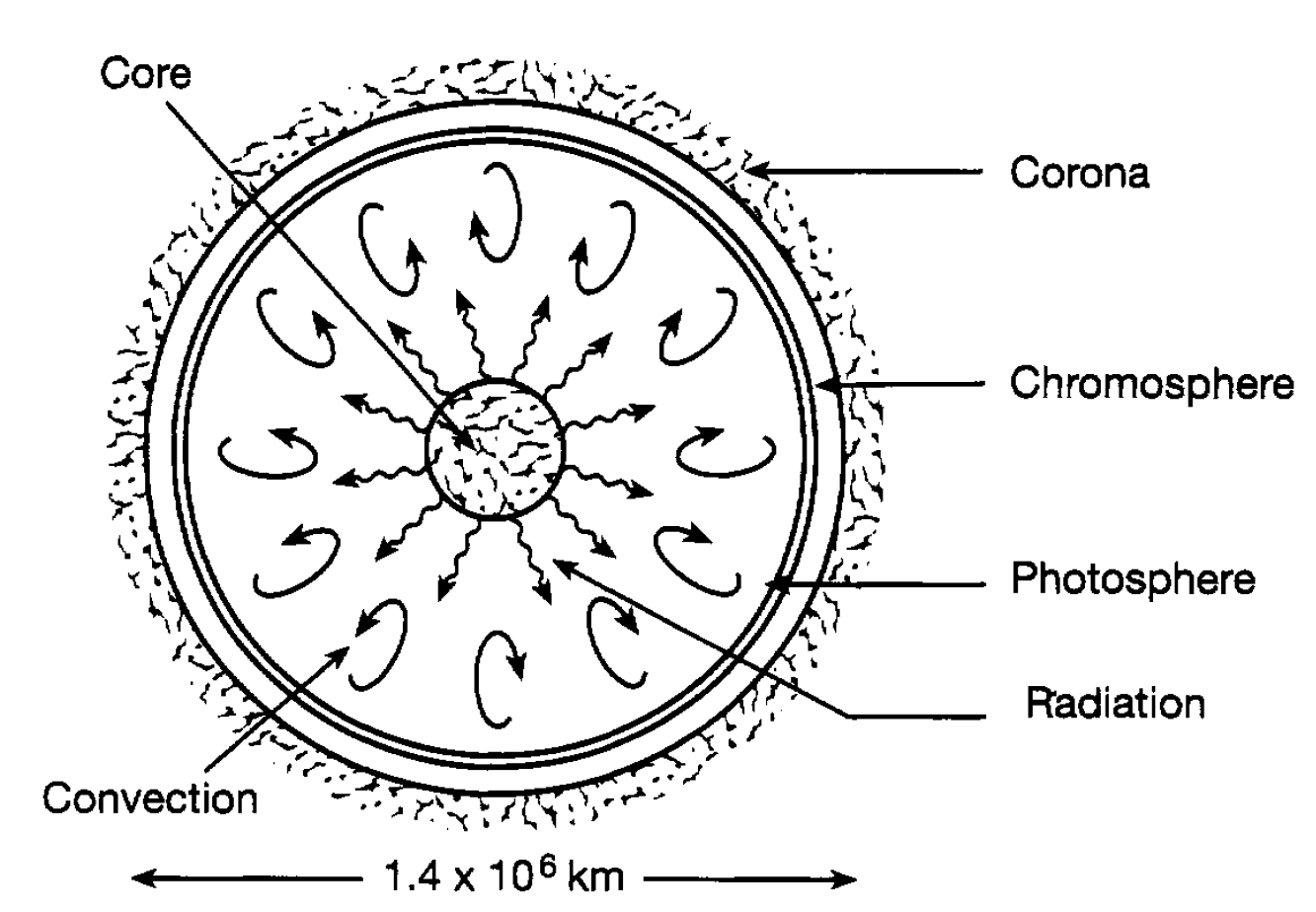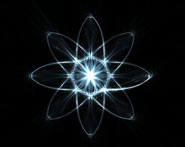


 الفيزياء الكلاسيكية
الفيزياء الكلاسيكية
 الكهربائية والمغناطيسية
الكهربائية والمغناطيسية
 علم البصريات
علم البصريات
 الفيزياء الحديثة
الفيزياء الحديثة
 النظرية النسبية
النظرية النسبية
 الفيزياء النووية
الفيزياء النووية
 فيزياء الحالة الصلبة
فيزياء الحالة الصلبة
 الليزر
الليزر
 علم الفلك
علم الفلك
 المجموعة الشمسية
المجموعة الشمسية
 الطاقة البديلة
الطاقة البديلة
 الفيزياء والعلوم الأخرى
الفيزياء والعلوم الأخرى
 مواضيع عامة في الفيزياء
مواضيع عامة في الفيزياءThe Early Stages of the Universe and the Formation of Stars
We have seen in the last section that there is good evidence that the universe, including space and time itself, came into being with the big bang. The temperatures and energies involved were initially immensely high and the universe was an indescribable ‘soup’ of matter and radiation. After about 10-10s, however, the temperature dropped to around 1015 K and the corresponding energy was such that spontaneous symmetry breaking set in and the usual strong, electromagnetic and weak interactions came into operation. However, atoms and nuclei could not have existed particle energies would have been too high for them to have held together. There would have been simply the most basic of the elementary particles we have encountered. Most prolific would have been light particles such as electrons, positrons, neutrinos and their antiparticles together with photons. These would have been in a state of continual change as they interacted with each other through creation and annihilation processes. In addition, there would have been a few (roughly 1 part in l09) heavier particles, particularly protons and neutrons. As the universe continued to expand the temperature is estimated to have dropped from 1015K down to 1010K after one second and then, more slowly, down to l09K after a few minutes. At this latter temperature there would not have been sufficient disruptive energy around to prevent the neutrons and protons present joining together under the attraction of the nuclear force to form heavy hydrogen nuclei (deuterons  ) consisting of one proton and one neutron. In turn, these simple nuclei could then quickly combine with further neutrons and protons eventually to form the very stable helium nucleus (
) consisting of one proton and one neutron. In turn, these simple nuclei could then quickly combine with further neutrons and protons eventually to form the very stable helium nucleus ( ) consisting of two protons and two neutrons. Further, at this point in the evolution of the universe, most of the electrons and positrons would have annihilated each other to form photons and many neutrons would have beta decayed so that the contents of the universe would be mainly photons, neutrinos and antineutrinos together with a relatively small number of protons, helium nuclei and electrons and an even smaller number of deuterons. It is estimated that roughly 25% of the mass created in the first few minutes of the big bang was in the form of helium nuclei and the big bang theory is well supported by the fact that this percentage is found in present-day studies of the matter distribution in the universe. After the first few minutes the universe continued to expand rapidly. The cooling process continued so that after a few hundred thousand years its temperature was so low that it was possible for electrons to join up with the protons and helium nuclei to form hydrogen and helium atoms; the photons no longer had sufficient energy to knock the atoms to pieces. Thus, at this stage, matter in the universe was mostly in the form of a cloud of hydrogen (about 75% by mass) and helium (about 25% by mass) gas. Under the influence of their mutual gravitational attraction the gas atoms were then gradually drawn together to form stars and galaxies. Here it is interesting to note that small variations recently observed in the background electromagnetic radiation are indicative of early variations in the density of the universe, which would have acted as focal points for their formation. This falling together means that gravitational potential energy is converted into kinetic energy of the atoms, leading to a continual increase in the temperature at the centre of a star so that atoms are ionized the electrons are knocked out-and a plasma of ions and electrons is formed. Eventually the temperature of the core becomes so high, around 1.5×107K, that the kinetic energies of the hydrogen nuclei (protons) are sufficient to overcome the electric repulsive forces between them and to set in train the ‘hydrogen burning’ fusion process. The net effect of the basic fusion process is that four protons are converted into helium with the emission of two positrons and two neutrinos and the release of energy equal to about 25MeV. In the sun, the rate of energy generation from hydrogen burning is around 5 × 1020 MW, a factor of 1011 larger than the level of energy production in the USA. This energy is transmitted to the outer layers of the star and emitted as electromagnetic radiation. Thus the structure of the sun is of the form shown in figure 1.1. It consists of the central core generating an immense amount of energy through nuclear fusion surounded by a large zone consisting of plasma through which energy is transmitted to the surface and in which convection currents continually feed protons
) consisting of two protons and two neutrons. Further, at this point in the evolution of the universe, most of the electrons and positrons would have annihilated each other to form photons and many neutrons would have beta decayed so that the contents of the universe would be mainly photons, neutrinos and antineutrinos together with a relatively small number of protons, helium nuclei and electrons and an even smaller number of deuterons. It is estimated that roughly 25% of the mass created in the first few minutes of the big bang was in the form of helium nuclei and the big bang theory is well supported by the fact that this percentage is found in present-day studies of the matter distribution in the universe. After the first few minutes the universe continued to expand rapidly. The cooling process continued so that after a few hundred thousand years its temperature was so low that it was possible for electrons to join up with the protons and helium nuclei to form hydrogen and helium atoms; the photons no longer had sufficient energy to knock the atoms to pieces. Thus, at this stage, matter in the universe was mostly in the form of a cloud of hydrogen (about 75% by mass) and helium (about 25% by mass) gas. Under the influence of their mutual gravitational attraction the gas atoms were then gradually drawn together to form stars and galaxies. Here it is interesting to note that small variations recently observed in the background electromagnetic radiation are indicative of early variations in the density of the universe, which would have acted as focal points for their formation. This falling together means that gravitational potential energy is converted into kinetic energy of the atoms, leading to a continual increase in the temperature at the centre of a star so that atoms are ionized the electrons are knocked out-and a plasma of ions and electrons is formed. Eventually the temperature of the core becomes so high, around 1.5×107K, that the kinetic energies of the hydrogen nuclei (protons) are sufficient to overcome the electric repulsive forces between them and to set in train the ‘hydrogen burning’ fusion process. The net effect of the basic fusion process is that four protons are converted into helium with the emission of two positrons and two neutrinos and the release of energy equal to about 25MeV. In the sun, the rate of energy generation from hydrogen burning is around 5 × 1020 MW, a factor of 1011 larger than the level of energy production in the USA. This energy is transmitted to the outer layers of the star and emitted as electromagnetic radiation. Thus the structure of the sun is of the form shown in figure 1.1. It consists of the central core generating an immense amount of energy through nuclear fusion surounded by a large zone consisting of plasma through which energy is transmitted to the surface and in which convection currents continually feed protons

Figure 1.1: The structure of the sun.
into the core. The surface, known as the photosphere, is at a temperature of around 6000 K leading to the emission of the star’s light. Beyond the surface is the chromosphere, which is a layer of rarefied gases, and beyond that is the corona, consisting of extremely fine dust particles at a very high temperature. The sun is also emitting streams of particles, particularly protons and helium nuclei, into space and is losing mass at the rate of 1 part in l013 or 1014 in a year. This emission is known as the solar wind and, when it interacts with molecules in the earth’s atmosphere under the influence of the earth’s magnetic field, leads to such phenomena as the aurora borealis-the northern lights and geomagnetic storms.



|
|
|
|
صنع الذكريات والتفكير يدمر الدماغ.. دراسة تشرح السبب
|
|
|
|
|
|
|
الصين.. عودة كاسحتي الجليد إلى شنغهاي بعد انتهاء بعثة استكشافية إلى القطب الجنوبي
|
|
|
|
|
|
جامعة الكفيل تكرم الفائزين بأبحاث طلبة كلية الصيدلة وطب الأسنان
|
|
|
|
مشروع التكليف الشرعي بنسخته السادسة الورود الفاطمية... أضخم حفل لفتيات كربلاء
|
|
|
|
ضمن جناح جمعيّة العميد العلميّة والفكريّة المجمع العلمي يعرض إصداراته في معرض تونس الدولي للكتاب
|
|
|
|
جامعة الكفيل تعقد مؤتمرها الطلابي العلمي الرابع
|